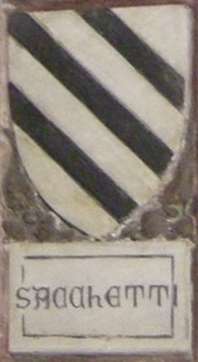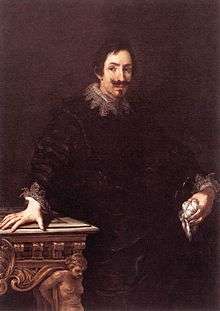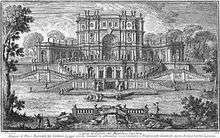House of Sacchetti
The House of Sacchetti is an Italian noble family originating in Tuscany whose earliest documented member Merlo lived during the late 10th and early 11th centuries. The name of the family is derived from one or more members known as Sacchetto. According to Ugolino di Vieri (1438–1516),"nobile Sacchetti genus est, moenia primus romanus sangius".
History
Eugenio Gamurrini in his Istoria genealogica delle famiglie nobili toscane et umbre (1668–1685) placed the family's origin within the "gens Cornelia", one of the most distinguished families of the Roman Republic, whose first known Consul was Servius Cornelius Cossus Maluginensis, in 485 BC. According to Gamurrini the Sacchetti descend from the Cornelii Merulae branch. The family was certainly well established in Florence during the 12th century. Dante Alighieri mentions the family in The Divine Comedy, Paradise Canto XVI in which Dante's Great-grandfather lists the ancient families of Florence, "Grand'era gia` la colonna del Vaio (Pigli), Sacchetti, Giuochi, Fifanti e Barucci e Galli e quei ch'arrossan per lo staio"(a reference to the Tosinghi family that were a branch of the Visdomini) (Great was already the column of minever, Sacchetti, Giuochi, Fifanti, and Barucci and Galli, and they who blush for the bushel.) Dante also recounted meeting his father’s first cousin, Geri del Bello in The Inferno, Canto XXIX:1-36. Dante placed his cousin in the ninth chasm, among the sowers of discord for the family's dispute with the Sacchetti, most likely Brodaio Sacchetti, consul in 1203. At the time of Dante's vision the feud had not been settled. The families were finally reconciled in 1342.

Trancept of Santa Croce, Florence. Tomasso was married to Tancia Strozzi, daughter of Palla Strozzi who was exiled by the Medici. Tomasso appears to have been the only son-in-law of Palla Strozzi not to have suffered under the Medici.
Branches

According to Ugolino di Vieri the Sacchetti originated in Fiesole and were among the families forced to transfer and take up residence in Florence after Fiesole was finally conquered by Florence in 1125. One of the earliest surviving records is in the year 1137; Sacchetto and his brother Bernardino di Bonizo di Merlo contract a tower association with members of the Uberti family.(Strozziane Uguccioni, 1137 agosto 11). It was the descendants of Sacchetto that would eventually use this as a patronymic and become known as the Sacchetti. Brodaio di Sacchetto was elected to the Council of the Florentine Republic in 1197 and Consul in 1202. While Cingisallo and Albizzo di Rovinoso are listed among the Anziani for the year 1200. When Florentine society was divided between the political factions of the Guelf and the Ghibellines most members of the family sided with the Guelf party. In 1260 the Teghiaio and Giambeto Sacchetti fought in the Battle of Montaperti against the Ghibellines of Siena while Gaglia di Upizzino Sacchetti was one of the men charged with defending the Carroccio, a wheeled altar which was the rallying point for a medieval army. The Sienese defeated the Florentines and the Sacchetti were exiled but later returned with the eventual defeat of the Sienese and the final expulsion of the Florentine Ghibellines. Despite the families support for Guelf party the Sacchetti were barred from holding public office with the promulgation of the Ordinances of Justice in 1293 and 1295. The ordinances were intended to exclude Ghibelline sympathizers and nobles with a reputation for their bellicose nature and a predilection for violence to impose their will. Eventually the family returned to the council and the highest offices of the Republic. The family has two main branches, one that remained in Florence up to the time of the hegemony of the Medici and relocated to Rome in the sixteenth century and the Neapolitan branch that went into the service of the Normans in southern Italy shortly after their forced transfer from Fiesole.
The Neapolitan branch descended from two brothers. Lancillotto and Avellino di Sacchetto. Lancillotto's son Cesare was Bishop of Melfi. Ottone Sacchetti was the Latin Patriarch of Antioch. Avellino received privileges from the Norman King Roger II of Sicily and created Gran Giustiziere of the kingdom. Later generations of this line included Gezzolino di Simone di Avellino, created Baron of Alessano in 1173 by King William the Good. Gezzolino also held the baronages of Ceglia, Campia, Cavallino, Sellino, Ginosa, Castrignano, Levarano, Maladregno, Muflafia, Oira and Squinzano. Gezzolino's son Ludovcio was married to Emilia Acciaioli who bore him three sons: Angelo, Iacopo and Alberico, who was the Praetor of Tuscolano in 1224 for the Emperor Frederick II. Pietro Antonio di Agnelo, Knight of the Golden Spur, Governor of the city of L'Aquila for King Charles II of Anjou in 1285. Giovanni Pietro was theGran Giustiziere of Abruzzo in 1268. Lazzarino, the son of Pietro Antonio was appointed the Quartermaster General for Abruzzo by Charles II in 1299. Andrea Guido, nicknamed Guidotto was appointed as replacement Governor of Salerno by King Robert of Naples in 1338 due to the Governor being abset for war negotiations. Guidotto was married to Cecilia Brancacci. They had at least three sons: Carlo, Andrea and Filippo. Carlo, Baron of San Demetrio and Policastrello and his wife Isabella De Aloe contracted a marriage for his son Giromlamo to Laudomia de Tufo on the 4th of April 1412. Giromino and Laudomia de Tufo had two sons: Alfonso and Matteo. Queen Giovanna II appointed Alfonso a Governor in the province of Calabria Citra. Alfonso's son Giovanni Alfonsino was granted privileges by King Alfonso II in 1453. Pietro Antonio appointed Quartermaster of Cosenza by Ferdinand of Aragon in 1483. Francesco Antonio Sacchetti, born 1595 in San Severo, Foggia, Puglia was appointed bishop of San Severo 1 Oct 1635, and consecrated on 7 Oct 1635 by Cardinal Giulio Cesare Sacchetti. On 13 Jan 1648 he was appointed bishop of Troia, Foggia, Puglia and died in that office in June 1662.
The Roman is descended from Giovanni Battista Sacchetti, the son of Matteo Sacchetti b. 1485 and Nanna Carducci and Francesca Altoviti, the daughter of Alessandro Altoviti. Matteo and Francesca had nine children Matteo (died young), Bindo, Vincenzo, Clarice, Sandrina, Marcello, Giulio, Alessandro, Ottavia, Matteo and Gianfrancesco. The family transferred to Rome from Florence in the late sixteenth century after the collapse of the republic and the establishment of the Principate of the Medici.
Gianfrancesco was the Commissary General of the Papal troops in Valtellina in 1623 and 1626 and was created Marquis of Rigattini in 1632 and a Marquis of the Baldachin in 1633 giving him the rank of Prince at the papal court. The current Roman branch is descendant from Matteo and his wife Cassandra Ricasoli-Rucellai. Their son Don Giovanni Battista and Caterina Acciaioli inherited his uncle’s title and their son Matteo who married Chiara Orsini exchanged the Marquisate of Castel Rigattini for the Marquisate of Castel Romano. Their son Giulio married Maddalena Azzan. Their son Scipione became the Chief Quartermaster of the Apostolic Palaces in 1794, a title held by the family until the dissolution of the papal court in the 1970s. Scipione married Eleonora Cenci Bolognetti daughter of Girolamo Prince of Vicovaro. Their son Urbano married Beatrice Orsini, daughter of Domenico Duke of Gravina and Principe of Solofra and Maria Luisa Torlonia of the Dukes of Poli and Guadagnolo. Their younger son Luigi married Maria Colonna-Barberini, Princess and heiress of Palestrina and with a decree from the Italian state Luigi assumed his wife’s titles and assumed the surname Barberini. The eldest son of Urbano and Beatrice Orsini, Giulio married Teresa, the daughter of the Marquis Antonio Gerini and his wife Anna Maria Borghese. Their son Giovanni Battista was a Councilor to the State of the Vatican and married Matilda Lante Montefeltro della Rovere. Their son Giulio, the last Chief Quartermaster of the Vatican, married Giovannella Emo Capodilista, the daughter of the Count Alvise and Maria Henriqueta Alvares Pereira de Mello of the Dukes of Cadaval. Giulio and Giovannella had five children. The current head of the family is their son Urbano





